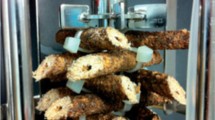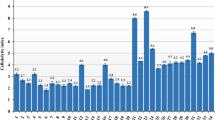Abstract
Lysozyme (1,4-β-N-acetylmuramidase) is a lytic enzyme, which degrades the bacterial cell wall. Lysozyme has been of interest in medicine, cosmetics, and food industries because of its anti-bactericidal effect. Kluyveromyces lactis K7 is a genetically modified organism that expresses human lysozyme. There is a need to improve the human lysozyme production by K. lactis K7 to make the human lysozyme more affordable. Biofilm reactor provides high biomass by including a solid support, which microorganisms grow around and within. Therefore, the aim of this study was to produce the human lysozyme in biofilm reactor and optimize the growth conditions of K. lactis K7 for the human lysozyme production in biofilm reactor with plastic composite support (PCS). The PCS, which includes polypropylene, soybean hull, soybean flour, bovine albumin, and salts, was selected based on biofilm formation on PCS (CFU/g), human lysozyme production (U/ml), and absorption of lysozyme inside the support. To find the optimum combination of growth parameters, a three-factor Box–Behnken design of response surface method was used. The results suggested that the optimum conditions for biomass and lysozyme productions were different (27 °C, pH 6, 1.33 vvm for biomass production; 25 °C, pH 4, no aeration for lysozyme production). Then, different pH and aeration shift strategies were tested to increase the biomass at the first step and then secrete the lysozyme after the shift. As a result, the lysozyme production amount (141 U/ml) at 25 °C without pH and aeration control was significantly higher than the lysozyme amount at evaluated pH and aeration shift conditions (p < 0.05).






Similar content being viewed by others
References
Anderson MJ, Whitcomb PJ (2000) DOE simplified: practical tools for effective experimentation. Productivity, Portland
Capdeville B, Rols JL (1992) Introduction to biofilms in water and wastewater treatment. In: Melo LF, Bott TR, Fletcher M, Capdeville B (eds) Biofilms—science and technology. Kluwer, Dordrecht, pp 13–20
Cheng K, Demirci A, Catchmark JM (2010a) Advances in biofilm reactors for production of value-added products. Appl Microbiol Biotechnol 87:445–456
Cheng K, Demirci A, Catchmark JM (2010b) Enhanced pullulan production in a biofilm reactor by using response surface methodology. J Ind Microbiol Biotechnol 37:587–594
Choi S, Paik H, Lee S, Nihira T, Hwang Y (2004) Enhanced productivity of human lysozyme by pH-controlled batch fermentation of recombinant Saccharomyces cerevisiae. J Biosci Bioeng 98:132–135
Choudhury B, Swaminathan T (2006) Lactic acid fermentation in cell-recycle membrane bioreactor. Appl Biochem Biotechnol 128:171–84
Christensen BE, Characklis WG (1990) Physical and chemical properties of biofilms. In: Characklis WG, Marshall KC (eds) Biofilms. Wiley, New York, pp 93–131
Demirci A, Pometto AL III (1995) Repeated-batch fermentation in biofilm reactors with plastic-composite supports for lactic acid production. Appl Microbiol Biotechnol 44:585–589
Demirci A, Pometto AL III, Ho KLC (1997) Ethanol production by Saccharomyces cerevisiae in biofilm reactors. J Ind Microbiol Biotechnol 19:299–304
Demirci A, Pongtharangkul T, Pometto AL III (2007) Applications of biofilm reactors for production of value-added products by microbial fermentation. In: Blaschek HP, Wang HH, Agle ME (eds) Biofilms in the food environment. Blackwell, Ames, pp 167–189
Gilby C (2001) Lysozyme—a natural way to manage fermentation risks? http://www.cix.co.uk/~cgilby/lysozyme1.pdf. Accessed 16 September 2010.
Gonzalez-Siso MI, Feire-Picos MA, Ramil E, Gonzalez-Dominguez M, Torres AR, Cerdan ME (2000) Respirofermentative metabolism in Kluyveromyces lactis: insights and perspectives. Enzyme Microb Technol 26:699–705
Ho GKL, Pometto AL, Hinz PN, Dickson JS, Demirci A (1997a) Ingredient selection for plastic composite supports used for l-(+)-lactic acid biofilm fermentation by Lactobacillus casei subsp rhamnosus. Appl Environ Microbiol 63:2516–2523
Ho GKL, Pometto AL, Hinz PN, Demirci A (1997b) Nutrient leaching and end product accumulation in plastic composite supports for L-lactic acid biofilm fermentation. Appl Environ Microbiol 63:2524–2532
Huang EL, Demirci A (2009) Enhanced human lysozyme production by Kluyveromyces lactis. Food Bioprocess Technol 2:222–228
Hughey VL, Johnson EA (1987) Antimicrobial activity of lysozyme against bacteria involved in food spoilage and food-borne disease. Appl Environ Microbiol 2165–2170
Islam R, Kite J, Baker AS, Ching A, Islam MR (2006) Affinity purification of hen egg lysozyme using sephadex G75. Afr J Biotechnol 5:1902–1908
Jayaraman VK (1992) The solution of hollow-fiber bioreactor design equations. Biotechnol Prog 8:462–464
Jolles P, Jolles J (1984) What’s new in lysozyme research? Mol Cell Biochem 63(165):189
Jolles P (1996) Lysozymes: model enzymes in biotechnology and biology. Birkhauser, Basel
MacKenzei DA, Gendron LCG, Jeenes DJ, Archer DB (1994) Physiological optimization of secreted protein production by Aspergillus niger. Enzyme Microb Technol 16:276–280
Maullu C, Lampis G, Basile T, Ingiani A, Rossolini CM, Pompei R (1999) Production enriched lysozyme biomass from cheese industry by products. J Appl Microbiol 86:182–186
Mehaia MA, Cheryan M (1984) Hollow fibre bioreactor for ethanol production: application to the conversion of lactose by Kluyveromyces fragilis. Enzyme Microb Technol 6:117–120
Melo LF, Oliveira R (2001) Biofilm Reactors. In: Cabral JMS, Mota M, Tramper J (eds) Multiphase bioreactor design. Taylor & Francis, New York, pp 271–309
Najafpour G, Younesi H, Syaahidah Ku Ismail K (2004) Ethanol fermentation in an immobilized cell reactor using Saccharomyces cerevisiae. Bioresour Technol 92:251–60
Qureshi N, Annous BA, Ezeji TC, Karcher P, Maddox IS (2005) Biofilm reactors for industrial bioconversion processes: employing potential of enhanced reaction rates. Microb Cell Fact 4:24
Pichler WJ, Campi P (1992) Allergy to lysozyme/egg white-containing vaginal suppositories. Ann Allergy 69:521–5
Pometto AL III, Demirci A, Johnson KE (1997) Immobilization of microorganisms on a support made of synthetic polymer and plant material. U.S. patent 5,595,893
Pongtharangkul T, Demirci A (2006a) Evaluation of culture medium for nisin production in repeated-batch biofilm reactor. Biotechnol Prog 22:217–224
Pongtharangkul T, Demirci A (2006b) Effects on pH profiles on nisin production in biofilm reactor. Appl Microbiol Biotechnol 71:804–811
Pongtharangkul T, Demirci A (2006c) Effects of fed-batch fermentation and pH profiles on nisin production in suspended-cell and biofilm reactors. Appl Microbiol Biotechnol 73:73–79
Richard MP, Ramesh CC, Khem MS (1965) A rapid and sensitive assay of muramidase. Proc Soc Exp Biol Med 119:384–386
Schleifer KH, Otto K (1972) Peptidoglycan. Types of bacterial cell walls and their taxonomic implications. Bacteriol Rev 36:407–477
Shuler ML, Kargi F (2002) Bioprocess engineering basic concepts. Prentice Hall, Upper Saddle River, pp 245–285
Swinkles BW, van Ooyen AJJ, Bonekamp FJ (1993) The yeast Kluyveromyces lactis as an efficient host for heterologous gene expression. Antonie Leeuwenhoek 64:187–201
Takako I, Tanaka R, Seustsugu M, Ishibashi M, Tonkunga H, Kikuchi M, Tokunga M (2004) Efficient secretion of human lysozyme from the yeast, Kluyveromyces lactis. Biotechnol Lett 26:1803–1808
Yoshimura K, Toibana A, Kikuchi K, Kobayashi M, Hayakawa T, Nakahama K, Kikuchi M, Ikehara M (1987) Differences between Saccharomyces cerevisiae and Bacillus subtilis in secretion of human lysozyme. Biochem Biophys Res Commun 145:712–718
Yu Z, Meng Q, Yu H, Fan B, Yu S, Fei J, Wang L, Dai Y, Li N (2006) Expression and bioactivity of recombinant human lysozyme in the milk of transgenic mice. J Dairy Sci 89:2911–2918
Acknowledgments
This work was supported in part by the Turkish Ministry of Education by providing scholarship to Duygu Ercan, the Pennsylvania Experiment Station, and Agricultural Sciences Graduate Student Competitive Grants Program. We also thank Dr. Anthony L. Pometto III for helping manufacturing plastic composite supports. Moreover, we thank Hilmar Ingredients Inc. (Hilmar, CA, USA) for providing lactose.
Author information
Authors and Affiliations
Corresponding author
Rights and permissions
About this article
Cite this article
Ercan, D., Demirci, A. Production of human lysozyme in biofilm reactor and optimization of growth parameters of Kluyveromyces lactis K7. Appl Microbiol Biotechnol 97, 6211–6221 (2013). https://doi.org/10.1007/s00253-013-4944-4
Received:
Revised:
Accepted:
Published:
Issue Date:
DOI: https://doi.org/10.1007/s00253-013-4944-4




